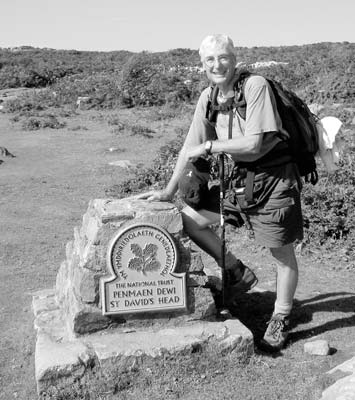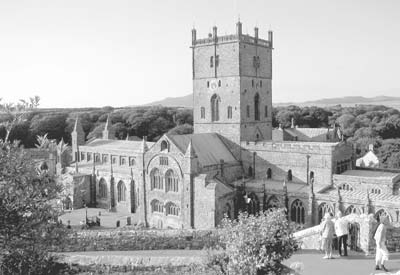Wales — walking the Pembrokeshire Coast Path
The wild and rugged coastline of Wales is as spectacular as the fancy travel brochures promise — indeed, even more so. This is particularly true in Pembrokeshire, Wales’ most western county. And the best way to enjoy its awesome scenery is by hiking the Pembrokeshire Coast Path, a 186-mile-long footpath, the majority of which is at cliff-top level.
So in September ’05, I set off for my fourth long-distance walk in the British Isles.
Challenges ahead
Probably the most challenging part of my trip was getting from London to St. Dogmael’s, Wales, where the trail begins. Yet this is where Great Britain’s crack public transportation system really came through.

I boarded the 10:30 a.m. express train to Swansea, Wales, at London’s Paddington Station, transferred to another train to Carmarthen, then took a bus to Cardigan and, finally, one more bus — the Poppit Rocket — to St. Dogmael’s, arriving at
5:00. (It sounds more complicated than it really is.) I enjoyed a comfortable night’s rest at Mary Cave’s B&B, then I was ready to go!
The Pembrokeshire Coast Path, one of Britain’s oldest and longest National Trails, follows the cliff top from St. Dogmael’s in the north to Amroth in the south. It normally takes about 12 days to complete the entire route, which was the plan I followed; however, many people prefer to walk shorter daily segments and use the local bus service to return each evening to a base lodge.
Either way, the walk can be as challenging as it is rewarding. Typically, during the first day, for example, walkers climb more than 3,000 feet on the 16-mile stretch to Newport. Since the highest cliffs seldom exceed 600 feet, that means you’re doing lots of ups and downs all day long.
I decided to do this trip in September because I knew the weather would be cool and relatively dry. Also, early fall is when the gray seals are drawn to Pembrokeshire’s isolated rocky coves to give birth to their pups.
Along the path
Overnights were spent in a combination of private B&Bs, small village inns and youth hostels.

There are scores of hostels in Wales, a country about the size of Minnesota, and 11 of them are spread along this coastal path. I stayed in three different kinds: an old stone schoolhouse, a former city hall and an abandoned military outpost. They all were wonderful.
At first I was concerned I’d get tired of the same scenery day after day, but I didn’t. Every bend in the cliffs offered a breathtaking, wild new vista. Every village was unique and enchanting in its own way. And the Welsh, like the Irish I’ve met, were warm, friendly and delighted to have “a Yank tackle the path.”
There wasn’t a day on my walk that I didn’t pass an abundance of archaeological sites, from Iron Age forts and Neolithic burial chambers to 19th-century lime kilns and holy wells. Pembrokeshire has been occupied by man for eons, and his ancient traces can be found everywhere.
A typical day
My daily routine began around 8 a.m. with an enormous Welsh breakfast. For lunch, I usually packed hard rolls, cheese, fruit and a candy bar which I enjoyed at my choice of gorgeous vistas.

My goal each day was to reach my stopping point by early afternoon, which would give me time to relax, clean up and do a little local sightseeing.
Then the only thing I had to worry about was selecting the village’s best pub for some lively conversation and my evening meal.
One of my favorite stops was St. Davids, the smallest city in Great Britain. Situated on a windswept, treeless peninsula of awesome ruggedness, it’s really not much more than a large village. But since it’s home to the magnificent St. David’s Cathedral, it officially qualifies as a city.
I enjoyed it so much I ended up spending two nights there.
Memorable moments
The most unforgettable evening of my trip took place in the ancient walled city of Tenby, where I attended a performance of the Pembroke Men’s Choir — 40 enthusiastic men singing their hearts and souls out in marvelous harmony. Their traditional concluding song is the Welsh National Anthem, sung in their native language. Everyone in the audience was standing and joining in with gusto.
However, the highlight of my trip took place in the tiny fishing village of Solva. This remarkable little place actually reminded me of the Hobbit village in “The Lord of the Rings” with its narrow twisting lanes, babbling brook and stone houses with slate roofs.
It was in their local pub that I discovered the joys of Buckleys Best Bitter, a local ale that left me wishing I was part Welsh. When I pointed out to the owner that my last name was Buckley, he promptly took down an old Buckleys Bitter advertising sign and insisted I take it home with me.
When I told him I was of Irish ancestry, he said that was close enough, pointing out that St. Patrick, himself, was born in Wales.
Ah, the Welsh. You gotta love ’em!
Pembrokeshire Coast Path tips
- Although the trail follows the coastline, it’s still easy to get on a wrong path from time to time. A critical item to have with you is an official guide of the Pembrokeshire Coast Path. I used the version by Brian John, although there are other choices. Copies can be purchased from a well-stocked bookstore or at www.amazon.com.
- Proper clothing is of paramount importance. A good waterproof jacket and pants are worth their weight in gold. Sturdy hiking boots that go above the ankle are a must, as is a quality hiking staff.
- The path may follow the cliff top but there are frequent descents to the shoreline and back, so be sure you can handle multiple climbs during a day — some as high as 600 feet (about the same as climbing the stairs of a 50-story building).
- Hike at your own pace; it’s not a race. Figure on averaging no more than two miles per hour; a mile and a half might be better for each of the first few days.
- You can walk the path from either direction. I chose north to south with the idea of getting the harder part done first.
- There is an abundance of excellent information available on the Internet. Begin with www.pembrokeshirecoast.org.uk and go from there.
- If you are traveling via London, you can get to the trail’s beginning by bus or train. Train is the fastest, and if you buy your tickets in advance you can save a lot of money; www.nationalrail.co.uk is the place to go. It will take a little patience, but it is worth it.
- The entire length of the path is serviced by a number of different bus companies making day trips from various locations (such as St. Davids), an attractive alternative to a “through walk.”

